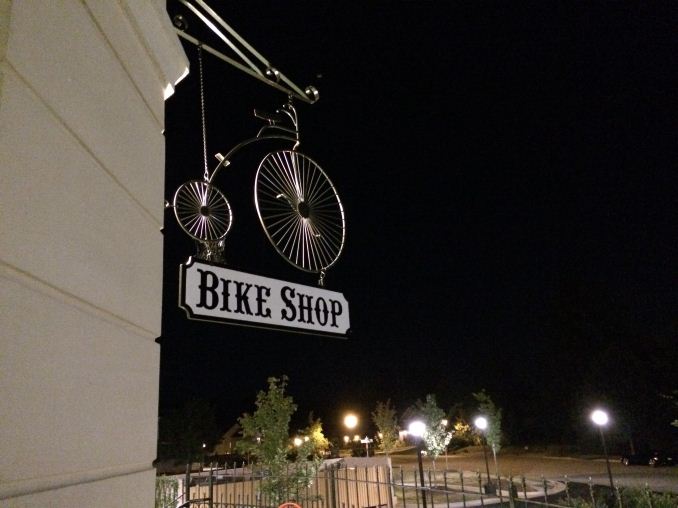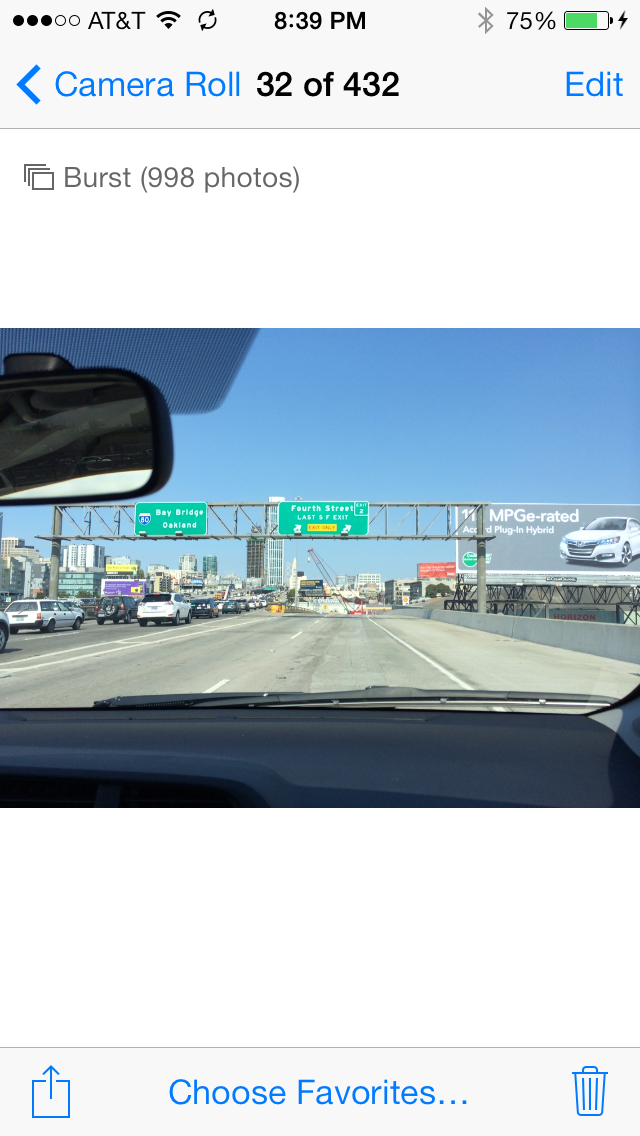The iPhone 5s Review
by Anand Lal Shimpi on September 17, 2013 9:01 PM EST- Posted in
- Smartphones
- Apple
- Mobile
- iPhone
- iPhone 5S
Camera
The iPhone 5s continues Apple’s tradition of sensible improvements to camera performance each generation. I was pleased to hear Phil Schiller deliver a line about how bigger pixels are a better route to improving image quality vs. throwing more at the problem. I remember hearing our own Brian Klug deliver almost that exact same message a year earlier when speaking to some engineers at another phone company.
The iPhone 5s increases sensor size compared to the iPhone 5. Last week Brian dug around and concluded that the 5s’ iSight camera sensor likely uses a format very similar to that of the HTC One. The difference here is while HTC opted for even larger pixels (arriving at 4MP), Apple chose a different balance of spatial resolution to light sensitivity with its 8MP sensor.
One thing ingrained in my mind from listening to Brian talk about optics is that there is no perfect solution, everything ultimately boils down to a selection of tradeoffs. Looking at Apple/HTC vs. the rest of the industry we see one set of tradeoffs, with Apple and HTC optimizing for low light performance while the rest of the industry chasing smaller pixel sizes. Even within Apple and HTC however there are differing tradeoffs. HTC went more extreme in pixel size while Apple opted for more spatial resolution.
| iPhone 4, 4S, 5, 5S Cameras | ||||
| Property | iPhone 4 | iPhone 4S | iPhone 5 | iPhone 5S |
| CMOS Sensor | OV5650 | IMX145 | IMX145-Derivative | ? |
| Sensor Format |
1/3.2" (4.54x3.42 mm) |
1/3.2" (4.54x3.42 mm) |
1/3.2" |
~1/3.0" (4.89x3.67 mm) |
| Optical Elements | 4 Plastic | 5 Plastic | 5 Plastic | 5 Plastic |
| Pixel Size | 1.75 µm | 1.4 µm | 1.4 µm | 1.5 µm |
| Focal Length | 3.85 mm | 4.28 mm | 4.10 mm | 4.12 mm |
| Aperture | F/2.8 | F/2.4 | F/2.4 | F/2.2 |
| Image Capture Size |
2592 x 1936 (5 MP) |
3264 x 2448 (8 MP) |
3264 x 2448 (8 MP) |
3264 x 2448 (8 MP) |
| Average File Size | ~2.03 MB (AVG) | ~2.77 MB (AVG) | ~2.3 MB (AVG) | 2.5 MB (AVG) |
Apple moved to 1.5µm pixels, up from 1.4µm in the iPhone 5. Remember that we’re measuring pixel size in a single dimension, so the overall increase in pixel size amounts to around 15%. Apple also moved to a faster aperture (F/2.2 vs. F/2.4 on the iPhone 5) to increase light throughput. The combination can result in significantly better photos than the outgoing 5 when taking photos in low light.
With the move to larger pixels, Apple has done away with its 2x2 binning mode in low light settings. The iPhone 5 would oversample each pixel after scene brightness dropped below a certain threshold to improve low light performance. The oversampled image would then be upscaled to the full 8MP, trading off spatial resolution for low light performance. The iPhone 5s doesn’t have to make this tradeoff. In practice I didn’t find any situations where the 5s’ low light performance suffered as a result. It always seemed to produce better shots than the iPhone 5.
Unlike some of the larger flagships we’ve reviewed lately, the iPhone 5s doesn’t ship with optical image stabilization (OIS). We’ve seen devices from HTC, LG and Nokia all ship with OIS, and have generally been pleased with the results. It’s not a surprise that the 5s doesn’t come with OIS as it’s largely the same physical platform as the outgoing 5. Still it would be great to see an Apple device ship with OIS. Perhaps on a larger iPhone.
As is always the case in space constrained camera systems, what Apple could not achieve in the physical space it hopes to make up for computationally. The 5s leverages electronic image stabilization as well as automatic combination of multiple frames from the capture buffer in order to deliver the sharpest shots each time.
Apple’s cameras have traditionally been quite good, not just based on sensor selection but looking at the entire stack from its own custom ISP (Image Signal Processor) and software. With the A7 Apple introduces a brand new ISP. Although we know very little about the new ISP, you can find references to Apple’s H6 ISP if you dig around.

Apple continues to ship one of the better auto modes among smartphone cameras I've used. I still want the option of full manual controls, but for most users Apple's default experience should be a very good one.
Capturing shots under iOS 7 is incredibly quick. Shot to shot latency is basically instantaneous now, thanks to a very fast ISP and the A7’s ability to quickly move data in and out of main memory. It’s impossible to write shots to NAND this quickly so Apple is likely buffering shots to DRAM before bursting them out to non-volatile storage.
The new ISP enables a burst capture mode of up to 10 fps. To active burst mode simply hold down the shutter button and fire away. The iPhone 5s will maintain a 10 fps capture rate until the burst counter hits 999 images (which was most definitely tested). Although it took a while to write all 999 images, all of them were eventually committed to NAND.
Photos captured in burst mode are intelligently combined as to not clutter your photo gallery. The camera app will automatically flag what it thinks are important photos, but you’re free to choose as many (or as few) as you’d like to include in your normal browsing view. Since all of the photos captured in burst mode are physically saved, regardless of whether or not you select them to appear among your photos, you can always just pull them off the 5s via USB.
The rear facing camera is paired with a new dual-LED True Tone flash. Rather than featuring a single white LED to act as a flash, Apple equips the iPhone 5s with two LEDs with different color tones (one with a cool tone and one with a warm tone). When set to fire, the 5s’ ISP and camera system will evaluate the color temperature of the scene, pre-fire the flash and determine the right combination of the two LEDs to produce the most natural illumination of the subject.
I’m not a huge fan of flashes, but I have to say that in a pinch the True Tone flash is appreciably better than the single LED unit on the iPhone 5. Taking photos of people with the new True Tone flash enabled produces much warmer and more natural looking results:
Even if your subject happens to be something other than a person I’ve seen really good results from Apple’s True Tone flash.
I still believe the best option is to grab your photo using natural/available light, but with a smartphone being as portable as it is that’s not always going to be an option.
I have to say I appreciate the vector along which Apple improved the camera experience with the iPhone 5s. Improving low light performance (and quality in low light situations where you’re forced to use a flash) is a great message to carry forward.
Front Facing Camera
The iPhone 5s and iPhone 5c share the same upgraded front-facing FaceTime HD camera. The front facing camera gets a sensor upgrade, also with a move to larger pixels (1.9µm up from 1.75µm) while resolution and aperture remain the same at 720p and F/2.4. The larger sensor size once again improves low light performance of the FaceTime HD camera (iPhone 5 left vs. iPhone 5s right):
































464 Comments
View All Comments
Wilco1 - Thursday, September 19, 2013 - link
The Geekbench results are indeed skewed by AES encryption. The author claimed AES was the only benchmark where they use hardware acceleration when available. There has been a debate on fixing the weighting or to place hardware accelerated benchmarks in a separate category to avoid skewing the results. So I'm hoping a future version will fix this.As for cross-platform benchmarking, Geekbench currently uses the default platform compiler (LLVM on iOS, GCC on Android, VC++ on Windows). So there will be compiler differences that skew results slightly. However this is also what you'd get if you built the same application for iOS and Android.
smartypnt4 - Thursday, September 19, 2013 - link
A lot of the other stuff in Geekbench seems to be fairly representative, though. Except a few of the FP ones like the blur and sharpen tests...It surely can't be hard to have Geekbench omit those results. I think if they did that, you'd see that the A7 is roughly 50-60% faster than the A6 instead of 100% faster, but I'm not sure there. I'd have to go and do work to figure that out. Which is annoying :-)
name99 - Wednesday, September 18, 2013 - link
I'd agree with the tweaks you suggest: (improved memory controller and prefetcher, doubling of L2, larger branch predictor tables).There is also scope for a wider CPU. Obviously the most simple-minded widening of a CPU substantially increases power, but there are ways to limit the extra power without compromising performance too much, if you are willing to spend the transistors. I think Apple is not just willing to spend the transistors, but will have them available to spend once they ditch 32-bit compatibility. At that point they can add a fourth decoder, use POWER style blocking of instructions to reduce retirement costs, and add whatever extra pipes make sense.
The most useful improvement (in my experience) would be to up the L1 from being able to handle one load+store cycle to two loads+ one store per cycle, but I don't know what the power cost of that is --- may be too high.
On the topic of minor tweaks, do we know what the page size used by iOS is? If they go from 4K to 16K and/or add support for large pages, they could get a 10% of so speed boost just from better TLB coverage.
(And what's Android's story on this front? Do they stick with standard 4K pages, or do they utilize 16 or 64K pages and/or large pages?)
extide - Wednesday, September 18, 2013 - link
Those are some pretty generous numbers you pulled out of your hat there. It's not as easy as just do this and that and bam, you have something to compete with Intel Core series stuff. No. I mean yeah, Apple has done a great job here and I wish someone else was making CPU's like this for the Android phones but oh well.name99 - Wednesday, September 18, 2013 - link
"Now, I will agree that this does prove that if Apple really wanted to, they could build something to compete with Haswell in terms of raw throughput."I agree with your point, but I think we should consider what an astonishing statement this is.
Two years ago Apple wasn't selling it's own CPU. They burst onto the scene and with their SECOND device they're at an IPC and a performance/watt that equals Intel! Equals THE competitor in this space, the guys who are using the best process on earth.
If you don't consider that astonishing, you don't understand what has happened here.
(And once again I'd make my pitch that THIS shows what Intel's fatal flaw is. The problem with x86 is not that it adds area to a design, or that it slows it down --- though it does both. The problem is that it makes design so damn complex that you're constantly lagging; and you're terrified of making large changes because you might screw up.
Apple, saddled with only the much smaller ARM overhead, has been vastly more nimble than Intel.
And it's only going to get worse if, as I expect, Apple ditches 32-bit ARM as soon as they can, in two years or so, giving them an even easier design target...)
What's next for Apple?
At the circuit level, I expect them to work hard to make their CPU as good at turboing as Intel. (Anand talked about this.)
At the ISA level, I expect their next major target to be some form of hardware transactional memory --- it just makes life so much easier, and, even though they're at two cores today, they know as well as anyone that the future is more cores. You don't have to do TM the way Intel has done it; the solution IBM used for POWER8 is probably a better fit for ARM. And of course if Apple do this (using their own extensions, because as far as I know ARM doesn't yet even have a TM spec) it's just one more way in which they differentiate their world from the commodity ARM world.
smartypnt4 - Wednesday, September 18, 2013 - link
@extide: agreed.@name99: It is very astonishing indeed. Then again, a high profile company like Apple has no problem attracting some of the best talent via compensation and prestige.
They've still got quite a long way to match Haswell, in any case. But the throughput is technically there to rival Intel if they wanted to. I would hope that Haswell contains a much more advanced branch predictor and prefetcher than what Apple has, but you never know. My computer architecture professor always said that everything in computer architecture has already been discovered. The question now is when will it be advantageous to spend the transistors to implement the most complicated designs.
The next year is going to be very interesting, indeed.
Bob Todd - Wednesday, September 18, 2013 - link
How many crows did you stuff down after claiming BT would be slower than A15 and even A12? Remember posting this about integer performance?"Silverthorne < A7 < A9 < A9R4 < Silvermont < A12 < Bobcat < A15 < Jaguar"
Apple's A7 looks great, but you've made so many utterly ridiculous Intel performance bashing posts that it's pretty much impossible to take anything you say seriously.
Wilco1 - Wednesday, September 18, 2013 - link
BT has indeed far lower IPC than A15 just like I posted - pretty much all benchmark results confirm that. On Geekbench 3 A15 is 23-25% faster clock for clock on integer and FP.The jury is still out on A12 vs BT as we've seen no performance results for A12 so far. So claiming I was wrong is not only premature but also incorrect as the fact is that Bay Trail is slower.
Wilco1 - Wednesday, September 18, 2013 - link
Also new version with A7 and A57 now looks like this:Silverthorne < A7 < A9 < A9R4 < Silvermont < A12 < Bobcat < A15 < Jaguar < A57 < Apple A7
Bob Todd - Wednesday, September 18, 2013 - link
Cherry picking a single benchmark which is notoriously inaccurate at comparisons across platforms/architectures doesn't make you "right", it just makes you look like more of a troll. Bay Trail has better integer performance than Jaguar (at near identical base clocks), so by your own ranking above it *has* to be faster than A12 and A15.You show up in every ARM article spouting the same drivel over and over again, yet you were mysteriously absent in the Bay Trail performance preview. Here's the link if you want to try to find a way to spin more FUD.
http://anandtech.com/show/7314/intel-baytrail-prev...
Apple's A7 looks great, and IT is still the powerhouse of mobile graphics. The A7 version in the iPad should be a beast. None of that makes most of your comments any less loony.